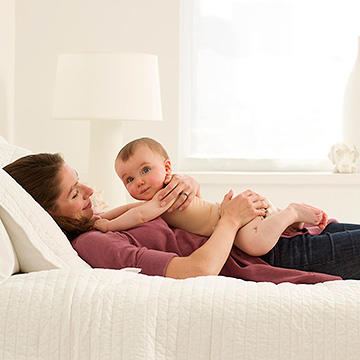The Importance of Tummy Time For Babies
As your little one is getting older it can be such a rewarding experience to see them grow and achieve new milestones. A Mum wants nothing more than to see their baby flourish. Tummy time is a vital tool to encourage brain and body development from birth and beyond.
From the moment your baby enters the world there is a complete order in which they will achieve certain milestones, one milestones will build on the next helping your bubs to grow up to be strong and capable. Tummy time is an incredibly important initial ability for bubs to have and will pave the way forward.
Tummy time has been proven to reduce positional plagiocephaly (a flat spot on the back of bubs head). Positional plagiocephaly can result in bubs developing problems with their neck and skull which may provide less room for the brain to grow. As a result, some infants may be prone to developmental delay such as sensory issues, speech and language trouble as well as issues surrounding attention and focus later on in life. We see this in practice because they are spending too much time on their back, or they have injuries which have developed from their position in utero or the birth causing misalignment in the spine which can interfere with their nervous system function. This may significantly limit their ability to enjoy tummy time.
Tummy time is more important than you may think, not only does it help to prevent positional plagiocephaly (flattening of the skull from lying on the back of their head so much) but it also encourages the development of the neck and back as well as assist in the development of shoulder strength. Most importantly though it is vitally important from brain development. Did you know your little one’s brain grows at an amazing rate throughout the first year of life (and thereafter)?
When babies are born, they are born with a C shaped spine and as they develop will reshape into an S shaped spine. As they learn to lie on their tummies and raise their head this forms the curve in their neck. This time is unbelievably important, as the development of this S shape curve is an essential step in assisting your bub to being able to roll over, sit upright, crawl, then walk and so on. Without the development of these natural spinal curves, these milestones would not occur. In additional to this structural development, tummy time can also drive feedback to the brain creating important connections. These connections help your little one to grow and develop their balance, coordination, visual tracking and their vestibular system (visual senses, motion equilibrium, spatial orientation and proprioception/touch, muscular control).
Tummy time should start from birth. A newborn needs around 5-10 minutes per day (with a gradual increase); this can be done lying on Mum or Dad’s chest. By 3 months old they should be comfortable to lie on their tummy for 2-3 minutes at each nappy change, which should add up to around 45 minutes a day. By this stage they should be comfortably turning their head side to side whilst on their tummy.
If your bub is unable to lie comfortably on their tummy and refuses every time this could be due to a number of reasons including restrictions and irritation in their spine movement or problems with their stomach. If you are noticing that your bub is not liking tummy time, a Chiropractor can help to assess your baby.
And remember… tummy time doesn’t have to be boring; there are so many ways to enjoy tummy time such as:
- After a bath dry bub while they lie on their belly, then give them a relaxing back massage for a couple of minutes in this position.
- Bub can lie on the parent’s belly while they recline back or lie on their thighs or shins as demonstrated below.
- It is important not to let bub get tired. If their head flops down or they begin to fuss, that is enough time.
- To make it more interesting for a child on the floor as they get a little older use different coloured and textured blankets or play-mats for improving their sensory experience.
- If your child initially finds it hard to lift and control their head, use a small rolled up towel under their chest and arms to raise them up slightly.
- Use this time to connect with you child. If you are there interacting with them, they will often last longer. Sing songs, chat to them, use colourful toys and read to them. Don’t use this time to catch up on chores the whole time.
Expectations for tummy time:
- In the first couple of months lift and turn their head from cheek to cheek.
- By 3 months – holding head up to 45-90 degrees and having little weight on elbows.
- By 4 months – holding head to 90 degrees for a period of time and lift chest of the floor using their forearms. They will often lift both arms and legs off to like doing a ‘superman’.
- By 5 months – bubs will often learn to roll and from here begin to crawl. So often they will move from their stomach straight away when put onto the floor. Just put them down on their stomach and they will decide what they do from here.
Having bubs lying on your chest or tummy! (This is best to do with skin-to-skin contact)
Holding toys or books in front of your baby and playing with them! (You can also use a non-breakable mirror so bubs can see their reflection)
Involve their siblings, I’m sure their older brother/sister would love to do some tummy time!
You can also rock bubs over a ball or your forearm!
- tummy time swiss ball
- tummy time forearm
If you would be interested in learning more about the importance of tummy time and how it assists in paediatric brain development, as well as some effective strategies to get your bub loving tummy time or some ways to trouble shoot when things aren’t going so well- We would love to help. Please call our practice on (03 5444 3388) or email me at [email protected] .
At Global Chiropractic we are passionate about caring for families from conception, pregnancy and birth to infant and childhood health (and beyond).
Dr. Elsie Rodgers (Chiropractic)
Global Chiropractic.






